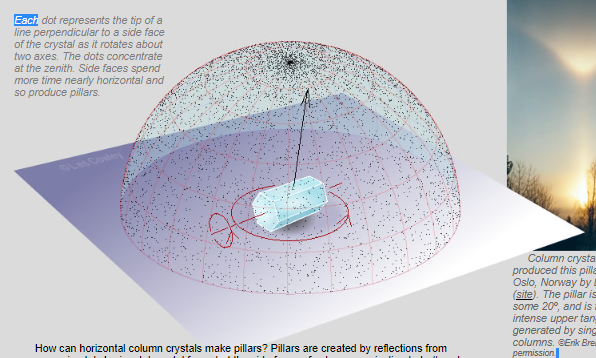Sun pillars from column crystals
Sun Pillars from Column Crystals: A Closer Look at this Phenomenon
Have you ever gazed up at the sky and been captivated by the sight of sun pillars? These stunning vertical columns of light that appear to reach towards the heavens are a mesmerizing atmospheric optical phenomenon. While we may often associate pillars with the sun, they can also be observed around other celestial objects such as the moon or even streetlights. In this article, we will take a closer look at a specific type of sun pillar formation - those created by column crystals.
Understanding the Mechanics Behind Sun Pillars
To comprehend how horizontal column crystals contribute to the creation of sun pillars, we need to delve into the intricate workings of these crystals. Unlike randomly oriented crystals, column crystals have a unique property - they possess orderly orientations and do not tumble. This characteristic is crucial in the formation of sun pillars.
A "singly oriented column" crystal aligns its long axis almost horizontally and has two rotational freedoms. Firstly, its long axis can point in any azimuthal direction (North, South, East, or West). Secondly, the crystal can assume various rotational positions around its long axis. These combined rotations play a pivotal role in determining the tilt directions of the crystal's side faces.
The Role of Crystal Orientation in Sun Pillar Formation
The tilt directions of a single side face can be visualized through the concept of a "normal vector," represented by a black arrow perpendicular to the face. As the column crystal rotates around its long axis, the tip of the normal vector sweeps along a line of longitude, consistently passing through the zenith. This phenomenon occurs regardless of the crystal's azimuthal orientation. In simpler terms, the face spends more time in a nearly horizontal position, making it more likely to contribute to the creation of sun pillars.
To gain further insights into this process, computer simulations have been conducted to map out the positions of the normal vector tips. By randomly selecting an azimuth and combining it with a rotational position around the crystal's long axis, the resulting tip position is plotted as a black dot on the sky sphere. Remarkably, these simulations reveal that the dots generated by this process concentrate near the zenith, rather than being evenly distributed across the sky. This concentration indicates that side faces of column crystals spend more time in a nearly horizontal position, making them prime contributors to the formation of sun pillars.
The Concentration of Sun Pillars at the Zenith
When observing the sky, we notice that each slice of latitude (altitude) contains an equal number of dots. However, as we move towards the zenith, the area of these slices decreases dramatically. Consequently, the dots become concentrated at the zenith. In other words, side faces of column crystals are more frequently in a nearly horizontal orientation than tilted at other angles. This prevalence of nearly horizontal faces explains why column crystals are capable of generating sun pillars.
In summary, the combination of two constrained crystal rotations in column crystals influences the direction of the normal vector, causing it to spend more time pointing near the zenith than in any other direction. As a result, side faces are more often in a nearly horizontal position, making them ideal candidates for producing sun pillars. This intriguing phenomenon serves as a reminder of the intricate and awe-inspiring nature of atmospheric optics.
Note: This article has been automatically converted from the old site and may not appear as intended. You can find the original article here.

Each dot represents the tip of a line perpendicular to a side face of the crystal as it rotates about two axes. The dots concentrate at the zenith. Side faces spend more time nearly horizontal and so produce pillars.

Column crystals probably produced this pillar imaged at Oslo, Norway by Erik Brenna (site). The pillar is unusually tall, some 20º, and is topped by an intense upper tangent arc also generated by singly oriented columns. ©Erik Brenna, shown with permission.
How can horizontal column crystals make pillars? Pillars are created by reflections from approximately horizontal crystal faces but the side faces of columns are inclined at all angles.
The key is that the crystals have orderly orientations - they do not tumble. A 'singly oriented column' drifts with its long axis nearly horizontal and has two rotational freedoms. (1) Its long axis can point in all azimuthal, NSEW, directions as indicated by the large arrowed red circle. (2) The crystal adopts all rotational positions around the long axis as shown by the smaller red circle.
Let's look at the resulting tilt directions of a single side face. These are most easily illustrated by the black arrow, the "normal vector", which points in a direction perpendicular to the face.
Imagine the crystal fixed at one azimuthal angle, say pointing east, and rotating around its long axis. The normal vector's tip sweeps along a line of longitude and passes through the zenith. Other azimuthal orientations similarly cause the vector to sweep along lines of longitude and always through the zenith. The zenith is a preferred normal vector direction. That is, the face spends more time nearly horizontal!
We can explore the vector tip positions by computer simulation. Choose a random azimuth, combine it with another randomly generated rotational position about the crystal long axis and plot the resulting tip position as a black dot on the sky sphere. The figure shows 10,000 dots generated this way.
Each slice of latitude (altitude) contains the same number of dots but the area of the slices decreases dramatically towards the zenith. The dots concentrate at the zenith, they are not evenly distributed over the sky. In other words, side faces spend more time nearly horizontal than tilted at other angles. And near horizontal faces make sun pillars!
To summarise, the combination of two constrained crystal rotations cause an arrow perpendicular to a side face to spend more time pointing near to the zenith than elsewhere. This means that side faces are therefore more often nearly horizontal than tilted at other inclinations. Nearly horizontal faces produce sun pillars and so, counter intuitively, column crystals generate pillars.
Note: this article has been automatically converted from the old site and may not appear as intended. You can find the original article here.
Reference Atmospheric Optics
If you use any of the definitions, information, or data presented on Atmospheric Optics, please copy the link or reference below to properly credit us as the reference source. Thank you!
-
<a href="https://atoptics.co.uk/blog/sun-pillars-from-column-crystals/">Sun pillars from column crystals</a>
-
"Sun pillars from column crystals". Atmospheric Optics. Accessed on December 21, 2024. https://atoptics.co.uk/blog/sun-pillars-from-column-crystals/.
-
"Sun pillars from column crystals". Atmospheric Optics, https://atoptics.co.uk/blog/sun-pillars-from-column-crystals/. Accessed 21 December, 2024
-
Sun pillars from column crystals. Atmospheric Optics. Retrieved from https://atoptics.co.uk/blog/sun-pillars-from-column-crystals/.